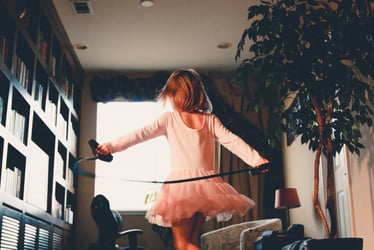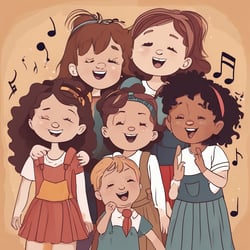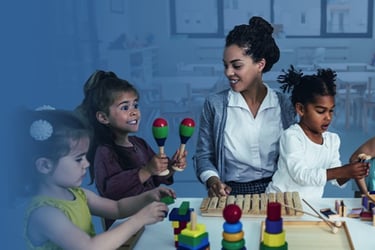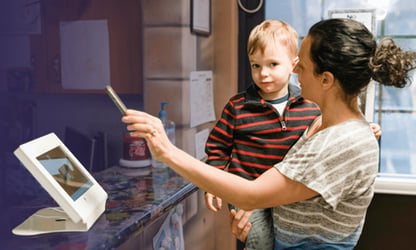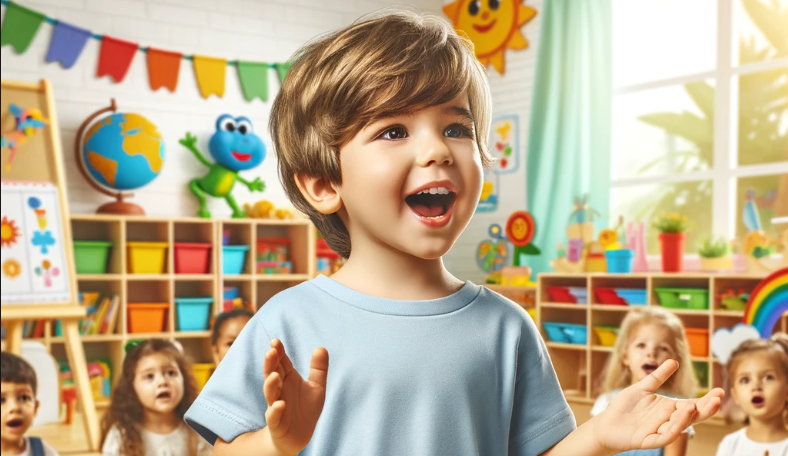
Preschool circle time activities are essential for engaging preschoolers in early childhood education. A successful circle time session requires circle time ideas that promote group activities and keep toddlers with short attention spans focused. Preschool teachers can use a variety of activities such as story time, music stops or asking the children to clap or take turns around the circle. These interactive circle time activities not only help children learn, develop their social skills and improve their fine motor skills.
Circle time is an important part of the daily routine in preschools, as it allows children to participate in a structured group activity where they know what to expect. During circle time, preschoolers and toddlers can also learn about the alphabet or engage in other educational activities. By making it fun and engaging, preschool teachers can keep children engaged and focused on the circle time lesson.
Circle time activities for preschoolers can also be used to review concepts or reinforce learning, making it an important tool of early childhood educators.
Table of Contents
- What Are Circle Time Activities?
- How to Plan Circle Time Activities
- Circle Time Best Practices
- 31 Activities for Effective Circle Time
- Interactive Circle Time Songs for Preschoolers
- Large Group Activities
- Activities That Promote Gross Motor Skills
- Circle Time Transition Activities
- Circle Time Community Building Activities
- Circle Time Life Skills Activities
- Circle Time Calming Activities
- Circle Time Activities to Improve Language Skills
- Get 70+ Editable and Printable Templates for Almost Every Preschool Situation
What Are Circle Time Activities?
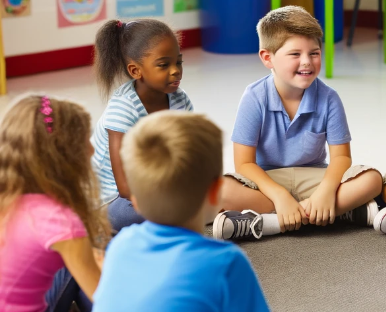
Definition of Circle Time Activities
Circle time activities are engaging group sessions where preschoolers gather to participate in various interactive tasks. Circle time also is essential for building a sense of community and enhancing learning through shared experiences.
Importance of Circle Time for Preschoolers
Circle time isn't just about fun and games; it's a critical component of a preschooler's development and an important part of the preschool routine. It helps kids develop essential social skills, like taking turns, listening and interacting with their peers.
Benefits of Incorporating Circle Time into a Preschool Routine
There are many benefits of circle time. They include:
- Social skills: During group time, kids learn to interact, share and play with others.
- Cognitive development: Engaging activities stimulate young minds, fostering curiosity and knowledge.
- Emotional growth: Group settings help children express their feelings and empathize with others, promoting strong social and emotional learning.
- Retention: Children retain information when you can keep them engaged. The use of circle time pushes kids to actively engage, helping preschool teachers push past distractions that usually inhibit learning.
How to Plan Circle Time Activities
A solid plan lays the foundation for effective activities. Here are a few planning tips to let the kids in your classroom unlock their full learning potential through different activities and fun games.
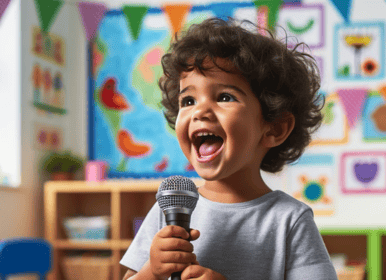
Choosing Age-Appropriate Circle Time Activities
The key to a successful circle time is selecting activities that resonate with the developmental stages of preschoolers. Opt for activities that are not too complex yet challenging enough to pique their interest and stimulate learning.
Incorporating Movement Activities into Circle Time
Kids need to move! Integrating physical activities keeps energy levels up and helps children stay engaged. Simple movements like clapping, jumping or stretching can make circle time more dynamic and fun.
Importance of Having a Routine for Circle Time Activities
Consistency is crucial for young children. A predictable structure provides a sense of security and helps children understand what to expect, making them more likely to pay attention during circle time, and then participate actively and enthusiastically.
Circle Time Best Practices
Teachers need to use circle time effectively to overcome the limits of children's attention spans and improve early childhood development outcomes. Here are just a few of the best practices to follow to make your activities a success.
Creating a Conducive Environment for Circle Time
The physical setting can significantly influence the effectiveness of circle time. Ensure the space is inviting, comfortable and free from distractions. A circle allows every child to see and be seen, promoting a sense of inclusivity and participation.
Tips for Keeping Preschoolers' Attention During Circle Time
- Variety is key: Choose activities to cater to different interests and learning styles and mix them up.
- Engage their senses: Use visual aids, sounds and tactile objects to enrich the experience.
- Be interactive: Encourage participation with questions, prompts and opportunities for children to lead.
Using Storytelling During Circle Time
Stories captivate children's imaginations and can be powerful tools for engagement. Use animated storytelling with props, voice changes and interactive elements to keep the narrative exciting and engaging.
Encouraging Social Interaction Through Circle Time Activities
Promote an environment where children feel comfortable expressing themselves and interacting with peers. Activities that require sharing, collaboration or turn-taking can help develop these vital social skills.
By implementing these best practices, educators can create a circle time experience that is not only educational but also enjoyable and engaging for preschoolers, laying a solid foundation for their growth and development.
31 Activities for Effective Circle Time
Circle time is a cherished part of any preschool day, bringing the whole class together for songs, stories, games and valuable learning experiences. However, keeping a group of energetic preschoolers engaged can be challenging. These 31 interactive circle time activities will have your students enthusiastically participating!
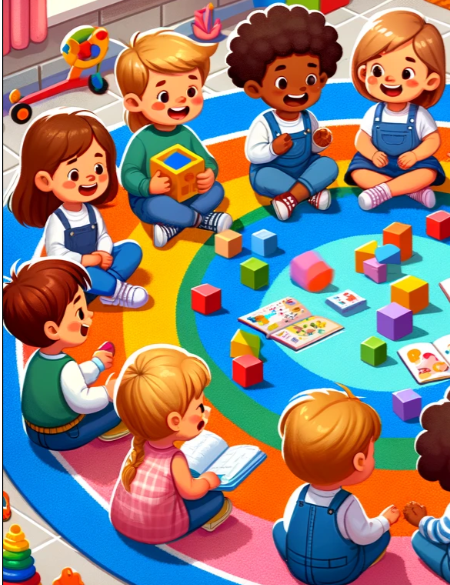
Interactive Circle Time Songs for Preschoolers
Get little bodies moving and voices singing with these interactive, fun circle time songs and chants. The motions and repetition build skills while expending energy.
1. The Hokey Pokey
Activity Overview: A classic tune that gets preschoolers up and moving different body parts in sequenced movement patterns.
Materials: Song lyrics or recording
Activity Instructions:
- Clear an open circular space for children to easily stand and stretch.
- Teach lyrics and movements by modeling each verse.
- Have children join in with corresponding body motions.
- Increase tempo for an energetic kinesthetic learning experience!
Variations: Use the hokey pokey to practice naming body parts, left/right concepts or following multi-step directions.
2. Open Shut Them
Activity Overview: Recite a simple rhyme using hands to model opposites like open/shut.
Materials: Rhyme lyrics
Activity Instructions:
- Show the basic "open/shut them" hand movement.
- Chant the verse together, copying the leader's motions.
- Add additional verses naming other opposites to model.
Variations: Replace opposites with parallel concepts like up/down, fast/slow or numbers that increase/decrease.
3. If You're Happy and You Know It
Activity Overview: Act out emotions through movement in this call-and-response song.
Materials: Lyrics or recording
Activity Instructions:
- Children stand in circle formation.
- Introduce each new feeling verse and corresponding motion.
- Children copy each emotion's movements when prompted.
- Combine multiple verses for a rhythmic feelings dance!
Variations: Swap out emotions with other skills like shapes, sounds or concepts.
Large Group Activities
Working together as a whole group develops social skills and teamwork. Circle time can also be used to reinforce community through interactive play. Here are just a few large group activities you can try.
4. Rhythm Stomp and Clap
Activity Overview: Children create rhythmic sound patterns together using body percussion.
Materials: None needed
Activity Instructions:
- Have children sit in a circle on the floor.
- Demonstrate stomping feet or clapping hands to make sounds.
- Establish a simple stomp-clap rhythm pattern for the group.
- Go around the circle with each child contributing the next sound in the pattern.
- Challenge them to keep the rhythm steady and listen for their turns!
Variations: Add movements like pats or finger snaps for more complex patterns.
5. Group Storytelling
Activity Overview: Ignite imaginations by collaboratively telling an improvisational story!
Materials: A simple starter story line
Activity Instructions:
- Children gather in a circle, sitting criss-cross.
- Begin telling a very basic story scenario, stopping after a couple sentences.
- The child to your left continues the tale for the next few lines.
- Continue passing the storytelling responsibility until your bizarre group story concludes!
Variations: Use props, puppets or felt pieces for a tactile storytelling experience.
6. Pass the Squeeze
Activity Overview: Get children to pass a gentle hand squeeze around the circle, waiting attentively for their turn.
Materials: None needed
Activity Instructions:
- Have children sit in a tight circle, holding hands.
- Start by squeezing the hand of the child to your left to begin.
- Children take turns squeezing the next hand in the designated direction.
- See how smoothly and quietly the squeeze can be passed around the circle!
Variations: Insert quiet movements, props or keywords to pass instead of squeezes.
Activities That Promote Gross Motor Skills
These activities are a great way to develop muscles and coordination through motions and full-body movements. Here are just a few tested activities to keep kids engaged during circle time.
7. Follow the Leader
Activity Overview: One leader performs movements that the whole group must copy in this classic game.
Materials: Music (optional)
Activity Instructions:
- Ask children to stand in a circle, facing inward.
- Choose one child to begin as the leader, facing the others.
- Leader performs motions like jumping, stretching, shaking for the circle to mimic.
- Leader changes by calling "New leader!" and picking someone else to follow.
Variations: Play musically by moving only when music plays, freezing when it stops.
8. Freeze Dance Party
Activity Overview: Grooving to music is interrupted when it stops — can preschoolers freeze in silly poses?
Materials: Upbeat music, player/speaker
Activity Instructions:
- Clear a circle space for children to move and dance freely.
- Start the dance party music and let kids get their sillies out!
- Periodically pause the music — children must freeze in their current poses.
- Praise fun, creative frozen positions! Resume the music to keep dancing.
Variations: Use theme music or pass a plush animal to get featured dancer spotlight.
9. I'm a Little... Motions
Activity Overview: Recite well-known verses while copying depicted motions together.
Materials: Song lyrics (optional, most are familiar tales)
Activity Instructions:
- Stand in a circle preparing to follow along.
- Introduce each verse's unique motions like "I'm a little teapot."
- Recite verses and make the movements as a group.
- Add new verses about objects or animals and create representative poses, e.g., tap your head!
Variations: Ask volunteers to act out each verse first for copying.
10. Body Part Bops
Activity Overview: A high energy movement game where children lightly bop different body parts as called.
Materials: Music or drum for bop rhythm (optional)
Setup: Children stand in an open circle ready to move.
Activity Instructions:
- Call out a body part like "arms!" and children bop them to the rhythm.
- Quickly change to new body parts for bopping — heads, tummies, knees!
- See how many body parts they can bop while staying energized!
Variations: Play musically by bopping to different rhythms or use flashcards for visuals.
11. Heads, Shoulders, Knees and Toes
Activity Overview: This classic game gets kids moving and learning about different body parts, enhancing both physical coordination and language skills.
Materials: None needed
Setup: Children stand in a circle with enough space to touch their heads, shoulders, knees and toes.
Activity Instructions:
- Sing the song "Heads, Shoulders, Knees and Toes" and perform the actions along with the lyrics.
- Start slowly to ensure all children understand the movements and body parts.
- Gradually increase the speed to add a fun challenge.
Variations: Pause the song at random points to see if children can freeze in place, adding a cognitive element to the physical activity.
Circle Time Transition Activities
Changing from one activity to the next requires attentive listening skills. These transitions keep students engaged during downtimes.
12. Bubble Freeze Dance
Activity Overview: Like freeze dance but using bubbles to pause and restart movement!
Materials: Bubble solution and wands
Activity Instructions:
- Blow bubbles ahead of time and let them fill the circle area.
- Children dance and move around to music or rhythmic clapping.
- When you stop blowing bubbles, they must freeze in place!
- Restart bubble blowing to signal the beginning of dance time again.
Variations: Use noise makers or clapping to start/stop instead of bubbles.
13. Mouse Trap
Activity Overview: Listen carefully and sneak across the "mouse trap" without getting caught!
Materials: Simple rope, tape or chalk "mouse trap" circle
Activity Instructions:
- Create a circular "trap" area on the floor with the line material.
- One child is designated the "cat" and stands inside the trap circle.
- Other "mice" sneak across the circle's line trap when the cat isn't looking.
- If caught crossing by the cat, that mouse rejoins the start line.
Variations: Add mouse squeaks for crossing or incorporate simple movements like hopping.
14. Progressive Barnyard Dance
Activity Overview: Listen for your animal cue, then scurry to join the growing dance party!
Materials: Music (optional, can use rhythmic clapping sounds)
Activity Instructions:
- Children stand spread around the circle's perimeter to start.
- Assign children different animal roles like chickens, horses, ducks, etc.
- Call out an animal and those children dance wildly toward the center.
- Keep adding animals until everyone is enthusiastically dancing together!
Variations: Incorporate animal sounds, have dance breaks between new groups joining.
15. Hickety Pickety Bumblebee
Activity Overview: Hone listening skills and build pattern recall with this chant and clap game.
Materials: None needed
Activity Instructions:
- Children sit in a circle facing inward.
- Teach the "hickety pickety bumblebee" chant with clapping pattern.
- The leader chants and claps a sequence, which students must echo back precisely.
- Patterns increase in complexity as they get the hang of the rhythmic game.
Variations: Award points or use visuals to emphasize successful pattern repeats.
16. Color, Color, Who's Not Listening?
Activity Overview: Children stay attentive, imitating the leader chant unless their "color" is called!
Materials: None needed
Activity Instructions:
- Children stand in a circle facing the leader.
- Leader walks around the circle chanting "Color, color, who's not listening?"
- Children echo the chants, all moving in rhythm together.
- If the leader calls a color that matches any child's clothing, they become silent!
Variations: Use other categories beyond colors like animals, shapes or foods.
Circle Time Community Building Activities
Strong bonds and teamwork develop when circle times bring students together as a supportive group. Build unity with these activities.
17. Line Up!
Activity Overview: Children problem-solve to silently organize themselves by given attributes.
Materials: None needed
Activity Instructions:
- Open area for children to line up across the circle space.
- Call out an attribute like "Get in a line from shortest to tallest!"
- Without talking, children figure out how to form that line.
- Check and adjust the order, then call out a new line category!
Variations: Line up by birthdays, first name letters, age and more! Get creative.
18. What's the Recipe, Chef?
Activity Overview: Develop communication and listening skills by following verbal instructions!
Materials: None needed
Activity Instructions:
- Children stand spread around the circle area.
- Choose a child to begin as the "chef" issuing instructions from the circle's center.
- Chef calls out step-by-step instructions for making a simple recipe.
- Children follow along with attached motions in sync like stirring, kneading, etc.
- New chefs get a turn adding instructions of their own!
Variations: Provide themed prop ingredients or create funny recipes to act out.
19. Pass the Appreciation
Activity Overview: Spread warmth and encouragement by sharing thoughtful compliments!
Materials: A simple item like rubber duck to pass around (optional)
Activity Instructions:
- Children sit in a tight circle holding hands or passing an object.
- Model giving a specific appreciation like "Joey did a great job listening!"
- That child receives the handshake, object or fist bump to pass on.
- Continue passing genuine appreciations until all have received and given.
Variations: Draw appreciation compliments from a jar to practice giving kindness.
20. Group Appreciation Circle
Activity Overview: Review standards and celebrate those who model expectations that day.
Materials: Pom-poms, beanbags or other small objects to toss
Activity Instructions:
- Students sit in a circle, with tossable objects in the center.
- Remind students of your class expectations before beginning.
- One at time, toss a pom-pom to someone demonstrating a specific skill like teamwork.
- That student receives the appreciation and tosses the next time.
Variations: Assign peer buddies to observe each other and share appreciations.
21. Barnyard Baby Animals
Activity Overview: Playfully match up with a partner in this quick-moving pairing game!
Materials: None needed
Activity Instructions:
- Students spread around the circle perimeter to start.
- Give each child either a "baby animal" or "mama animal" identity.
- When you call "Baby animals!" those kids emit their animal cry to find "mama."
- Once paired, they sit and wait while others scramble to find new partners.
Variations: Add movements like hopping, galloping or nuzzling baby sounds between rounds.
Circle Time Life Skills Activities
Make circle time activities that help develop personal skills like communication, confidence and self-regulation through these hands-on activities.
22. Taking Turns: Story Time
Activity Overview: Children practice patiently awaiting their turn to contribute to a shared story.
Materials: A simple starter story from a book, puppet or prop
Activity Instructions:
- Children sit in a circle around the story opener material.
- Begin an engaging story for a couple of sentences, then pause and ask children to share the next part of the story.
- Have the child to your left "take a turn" adding the next few story lines.
- The story makes its way around the circle taking turns building the tale!
Variations: Use prompts, story sticks or spinners to inspire new directions.
23. Mirror Me!
Activity Overview: Build self-awareness and body control through movement mirroring.
Materials: A basic movement sequence or rhythmic pattern
Activity Instructions:
- Children stand in a circle with enough space to move freely.
- Demonstrate a simple motion sequence like clapping, jumping or a dance.
- Students mirror precisely as the motions get more complex or speed up.
- Pause periodically to appreciate their attentive following skills.
Variations: Break into mirroring partners or use musical patterns.
24. Inside-Outside Circle
Activity Overview: Promote respectful dialogue by having paired conversations.
Materials: A engaging topic question like "What's your favorite animal?"
Activity Instructions:
- Children form two circles: an inner circle facing outward and an outer circle facing in.
- Model active listening skills with the first set of paired partners.
- Partners take turns sharing their thoughts on the prompt question.
- Call "Switch!" periodically to rotate partners and topics.
Variations: Use open-ended personal questions or share appreciations with new partners.
25. Roll a Feeling
Activity Overview: Develop emotional regulation skills and empathy through feeling charades.
Materials: A soft cube or ball labeled with different emotion faces
Activity Instructions:
- Put children in a circle, in an area clear of obstacles.
- Roll the emotion cube and identify the feeling face that lands upright.
- A volunteer acts out that emotion through body language and expressions.
- The group tries to guess the feeling based on the clues provided.
- Discuss personal experiences with that emotion being expressed.
Variations: Use emotion cards or masks for variety between rolls.
26. Slow Motion Game
Activity Overview: Challenge students to control impulsivity by moving in slow-motion sequences.
Materials: Music, movement cards or spinner (optional)
Activity Instructions:
- Spread children in a circle with enough personal space to move slowly.
- Have kids begin moving in slow-motion, like "slow-motion walking."
- Narrate movements to emulate like reaching, spinning, jumping (all super slow!).
- Students concentrate on precise, fluid motions with control.
Variations: Use movement cards, a spinner or music to alter the slow sequences.
Circle Time Calming Activities
Ensure circle times go smoothly by incorporating moments of mindfulness and quiet focus. These active and passive meditative activities reset the energy amid more high-energy daily activities.
27. Square Breathing
Activity Overview: Practice focused breathing techniques to find calmness and clarity.
Materials: Visual square breathing cards or shapes (optional)
Activity Instructions:
- Children seated with space, ready for some calming breaths.
- Model taking a deep belly breath while tracing one side of the square shape.
- Continue tracing all sides, holding breath between each new side.
- Exhale completely once the square outline has been traced through.
- Repeat the focused breath-work pattern using the visual guide.
Variations: Use movements like raising hands instead of shape visuals.
28. Body Scan
Activity Overview: Promote present-focused awareness through progressive muscle relaxation.
Materials: Calming meditation audio track (optional but helpful)
Activity Instructions:
- Children lie down on their backs with eyes closed.
- Guide the body scan meditation, concentrating on each area in turn.
- Have children tense and release muscles in areas like hands, arms, legs.
- Maintain steady breathing.
Circle Time Activities to Improve Language Skills
Developing oral language skills is vital during preschool years and circle time offers a perfect opportunity to integrate fun, interactive activities that enhance vocabulary, pronunciation and comprehension.
29. Rhyme Time
Activity Overview: Strengthen phonemic awareness and language rhythm through engaging rhyming games.
Materials: None needed
Activity Instructions:
- Start with a simple word and ask children to come up with rhymes.
- Take turns going around the circle, allowing each child to contribute a rhyming word.
- If a child is stuck, encourage others to help out, fostering a collaborative environment.
Variations: Use rhyming books as prompts or create a story where each sentence must rhyme with the last.
30. Story Sequencing
Activity Overview: Enhance comprehension and narrative skills by putting story events in order.
Materials: Picture cards or images from a story
Activity Instructions:
- Show the children the images and briefly discuss each one.
- Mix up the images and then ask the children to help put them back in the story's order.
- Discuss the sequence and how each part contributes to the story.
Variations: Use actual book illustrations or have children draw their sequence cards.
31. Descriptive Mystery Bag
Activity Overview: Build vocabulary and descriptive language skills with this sensory activity.
Materials: A bag filled with various objects
Activity Instructions:
- A child reaches into the bag without looking and describes the object they touch.
- Others guess what the object might be based on the descriptions given.
- Encourage the use of adjectives and sensory words for a richer description.
Variations: Include objects that start with a certain letter or correlate with a current theme or lesson for contextual learning.
Get 100+ Editable and Printable Templates for Almost Every Preschool Situation
We know preschools like yours are busy. That's why we made dozens of templates to help you manage the various aspects of your organization. With billing and invoicing, activity templates, forms and even marketing materials, we have it all. Download all 100 today!






